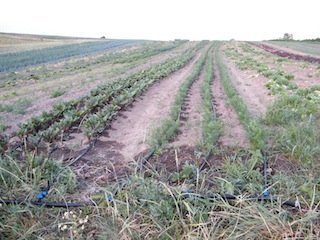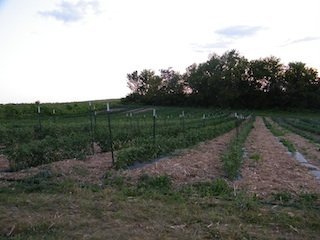
I know that there are a few of you out there who are opening up your CSA box each week and you’re pulling out these bunches of collards, kale and swiss chard, and you’re thinking to yourself, “what am I supposed to do with this?”. This newsletter is dedicated to those of you, probably some of the newbies, that have not yet fallen in love with greens. But I would be willing to place a bet with you that if you survived three full seasons as a CSA member, reading the newsletters, trying the recipes and wanting to learn how to eat greens, you would fall deeply, madly and passionately in love with GREENS!
I wish that there was something that I could write to you to help you learn to love them. I wish there was a dish that I could prepare for you to learn to crave them. And I wish there was something I could teach you about them that would help you realize how good they are for you. But because I am neither a writer, a chef or a nutritionist, I doubt that I can influence you in this way. So I have dug up a little information that I think you’ll find interesting about GREENS! Carrots (Right) and Beets (left) on drip irrigation lines! Good Work, Adam!
Carrots (Right) and Beets (left) on drip irrigation lines! Good Work, Adam!
They are useful in reducing the risk of cancer and heart disease since they are low in fat, high in dietary fiber, and rich in folic acid, vitamin C, potassium and magnesium, as well as containing a host of phytochemicals, such as lutein, beta-cryptoxanthin, zeaxanthin, and beta-carotene. One study showed that an increment of one daily serving of green leafy vegetables, lowered the risk of cardiovascular disease by 11 percent
Because of their high magnesium content and low glycemic index, green leafy vegetables are also valuable for persons with type 2 diabetes.
The high level of vitamin K in greens makes them important for the production of osteocalcin, a protein essential for bone health. The risk of hip fracture in middle-aged women was decreased 45% for one or more servings/day of green, leafy vegetables compared to fewer servings.
Green leafy vegetables are rich in beta-carotene, which can also be converted into vitamin A, and also improve immune function. Millions of children around the world have an increased risk of blindness, and other illnesses because of inadequate dietary vitamin A from green leafy vegetables.
Lutein and zeaxanthin, carotenoids found in dark-green leafy vegetables, are concentrated in the eye lens and macular region of the retina, and play a protective role in the eye. They protect against both cataract and age-related macular degeneration, the major cause of blindness in the elderly. Some studies suggest that lutein and zeaxanthin may help reduce the risk of certain types of cancer, such as breast and lung cancer, and may contribute to the prevention of heart disease and stroke.
Green veggies contain a variety of carotenoids, flavonoids and other powerful antioxidants that have cancer-protective properties.
Quercetin is a bioflavonoid found in leafy green vegetables. Quercetin has an antioxidant and anti-inflammatory activity and displays unique anticancer properties. Quercetin is a natural compound that blocks substances involved in allergies and acts as an inhibitor of mast cell secretion, and causes a decrease in the release of interleukin-6.
Information pulled from:
http://www.vegetarian-nutrition.info/updates/benefits-of-green-leafy-vegetables.php
Greens help alkalize the blood, while disease occurs easier in an acidic body. Greens play a vital roll in metabolizing fat and their concentration of nutrients give a boost of energy.
Kohlrabi X 2– These hearty little kohlrabis are holding on for their dear lives out there in this heat. They’re such little soldiers, bearing such a load on their shoulders. They’re really not looking like they want to tolerate the dry weather for much longer. Peel the kohlrabi and slice onto salads, dice into stir fry or grate into a slaw!
Green Onions- Green onions are a little bigger this week. The tops are little a little more brown from the dry weather. Use the bulbs all the way up to the tops of the greens in your cooking!
Broccoi or Cauliflower- As much as I aspire to grow beautiful broccoli and cauliflower, mother nature simply was not on our sides this spring. Broccoli and Cauliflower need consistently cool weather with plenty of moisture to mature properly. We decided it was better to give really funky looking broccoli and cauliflower rather than giving none at all. I promise you that we usually grow beautiful broccoli. Wait until Fall, I’ll prove it to you!
Swiss Chard or Red Curly Kale- The swiss chard was the best looking green out there, so we went for it. The collards, which were next up in the greens rotation, were really looking like they were under attack by the flea beetles.  Sunset over the tomatoes. Looking quite nice these days! Also on drip irrigation! Thanks, Adam for saving the tomatoes!
Sunset over the tomatoes. Looking quite nice these days! Also on drip irrigation! Thanks, Adam for saving the tomatoes!
Garlic Scapes- We had one large bin of scapes left to share with you, but the bunch sizes are about half the size from last week. We gave everyone a small garlic bulb in addition to the scapes. More garlic coming!
Cilantro- Cilantro comes in the heat of the summer to help cool us down. We were amazed to see that since the cilantro hasn’t seen rain in over a month, all of the dried leaves that are in the middle of the bunches. We did our best to make them look nice for you with the time we had.
Green Cabbage- Usually we have green cabbage for CSA boxes by Week 6 in the season, but this year, with very little rain and moistrue this spring, the cabbage really did not size up the way we hoped they would. We have another couple cabbage givings coming up that we are watering, so we’re hoping they’ll be a little bigger next time around. We find it’s better to give them while they’re small and cute and have mostly nice looking wrappers, rather than over-grown and huge with lotts of holes.
Cucumbers- Yowsers! Cucumbers are off with a bang! We were so happy to see them laying out there on the vine, looking so juicy and fine. Adam now has our cucumbers on drip-tape irrigation to ensure their precious little blossoms don’t dry up and die on us.
Summer Squash, Zucchini or Patty Pan- Summer Squash are the yellow, soft looking squashes. The zucchinis are the green, soft squashes and the patty pans are the UFO, spherical squashes. They all have a very similar texture and flavor, but their shape and colors vary greatly. They are a very watery plant. Summer squashes (a term that can group all three squashes) have very little flavor of their own, but are excellent at soaking up marrinades and seasonings that you infuse into them. We were slicing them lengthwise, soaking them in a bath of sunflower oil, balsamic vinegar, salt and pepper and then grilling them. They are also great on a kabob. Summer squashes can be chopped up, blanced and frozen or more simply grated and frozen as well.
Lettuce X 2- The lettuce is really suffering from this heat and drought. Their under-leaves were crispy and dead and the leaves that we did save feel a little tough from the heat and dry. We were still quite happy to be able to send everyone at least two heads this week!